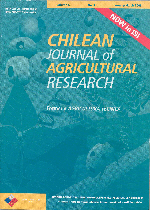
|
Agricultura Técnica
Instituto de Investigaciones Agropecuarias, INIA
ISSN: 0365-2807
EISSN: 0365-2807
Vol. 62, No. 4, 2002, pp. 519-529
|
 Bioline Code: at02049
Bioline Code: at02049
Full paper language: Spanish
Document type: Research Article
Document available free of charge
|
|
|
Agricultura Técnica, Vol. 62, No. 4, 2002, pp. 519-529
| en |
Beef Production with Yellow Serradella (Ornithopus CompressusL.) and Subterranean Clover (Trifolium SubterraneumL.) Under Dryland Conditions in the IXth Region, Chile
Rojas, Claudio; Romero, Oriella & Barrientos, Leticia
Abstract
During
the autumn and spring of 1998 and 1999, a study was carried out under dryland
conditions in the IXth Region to determine beef production, yield and quality
of DM, and degree of symbiotic N fixation of subterranean clover (Trifolium
subterraneum L.) and yellow serradella (Ornithopus compressus
L.) pasture. A completely randomized block experimental design was used. The DM
yield of the subterranean clover was 4700 kg ha-1 for both seasons,
and 5900 and 7100 kg ha-1 on serradella for the first and the second
seasons, respectively (P ≤.05). The chemical composition and symbiotic
fixation were similar in both pastures (P ≥.05). During the first season
the animal load in both pastures was 2.03 animals ha-1 and the increase
in liveweight was higher with serradella (P ≤.05) with 1.410 kg d-1
than with subterranean clover 1.324 kg d-1. In the second season the
animal load was 2.26 and 2.51 ha-1 for subterranean clover and serradella
pastures, respectively, and the liveweight gains were similar (P ≥.05)
with 1.326 and 1.309 kg d-1, for the same pastures, respectively. It
was concluded that the serradella pasture produced 27% and 17% higher DM and liveweight
gain than subterranean clover, with chemical composition and N fixation being
similar.
Keywords
dry matter yield, chemical composition, liveweight
|
| |
| es |
Producción de Carne Bovina en Praderas Naturalizadas de Serradella Amarilla (Ornithopus CompressusL.) Y Trébol Subterráneo (Trifolium SubterraneumL.), en Condiciones de Secano de la IX Región, Chile
Rojas, Claudio; Romero, Oriella & Barrientos, Leticia
Resumen
Durante el otoño y la primavera
de 1998 y 1999 se realizó un estudio en un predio de secano de la IX Región,
para determinar la producción de carne bovina, producción y calidad
de la MS, y grado de fijación simbiótica de N de las praderas naturalizadas
de trébol subterráneo (Trifolium subterraneum L.)
y de serradella amarilla (Ornithopus compressus L.). El diseño
experimental usado fue de bloques completos al azar. Las producciones de MS de
la pradera de trébol subterráneo fueron de 4.700 kg ha-1
en ambas temporadas y en serradela de 5.900 y 7.100 kg ha-1 para la
primera y segunda temporada, respectivamente (P ≤,05). La composición
química y fijación simbiótica en ambas praderas fueron similares
(P ≥,05). Durante la primera temporada la carga animal en ambas praderas
fue de 2,03 animales ha-1 y los incrementos de PV fueron mayores (P
≤,05) en la pradera de serradella con 1,410 kg d-1, respecto
a la de trébol subterráneo con 1,324 kg d-1. En la segunda
temporada la carga fue de 2,26 y 2,51 animales ha-1 para la pradera
de trébol subterráneo y de serradella, respectivamente, y los incrementos
de PV fueron similares (P ≥,05) con 1,326 kg d-1 y 1,309 kg
d-1, para las mismas praderas, respectivamente. Se concluyó que
la pradera de serradella produjo 27% y 17% mas MS y PV que el trébol subterráneo,
siendo similares su composición química y fijación simbiótica
Palabras-clave
producción de materia seca, composición química, peso vivo
|
| |
© Copyright 2002 - Instituto de Investigaciones Agropecuarias, INIA (Chile)
Alternative site location: http://www.inia.cl/at/agritec.htm
|
|
